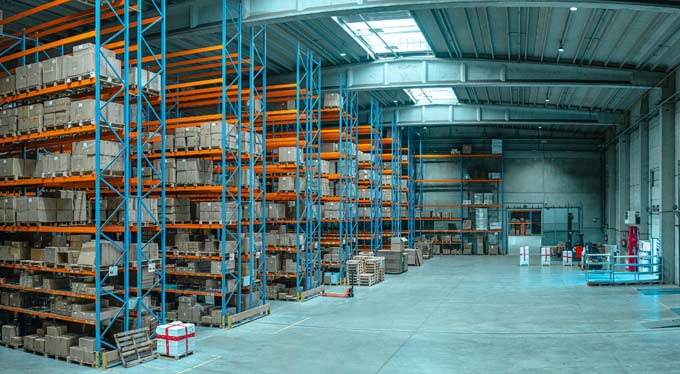Supply chains in 2022: what will change
What does 2022 hold for supply chains? Guest author Christian Lanng, CEO of Tradeshift, ventures a look into the crystal ball.

The last two years have been an object lesson in the power of events to throw the carefully calibrated machinery of global trade into chaos. In early 2020, it was Covid and the associated global power outages that threw supply chains into disarray. In March 2021, it was the container ship Ever Given that blocked the Suez Canal, the world's most strategic waterway. Companies need to prepare for the following in particular in 2022:
1. something unpredictable will happen
My first prediction is therefore the simplest of all: There will be an event that comes completely out of the blue and for which most manufacturers and suppliers will not be prepared. This event will further highlight the vulnerability of just-in-time supply chains. By this I mean the whole model of supply chains in general, where every broken link has an impact on the whole world.
Buyers and suppliers are increasingly aware that the models they have built over the past decades are no longer fit for purpose. They recognize that a paradigm shift is urgently needed to create the robust, resilient and agile supply chains of the future.
2. supply chains 2022: volatility is the new normal
Before the pandemic, companies were preparing for local or, at most, regional disruptions. Covid was an order of magnitude bigger than anything we had prepared for: hardly anyone had played out such a scenario or conducted a stress test on this scale. We will be busy for years to come trying to understand the implications of Covid, but we can predict one of the medium-term outcomes, which is that volatility will be a feature of global trade well into 2022.
This is already clearly evident: The Index of Global Trade Health Q3-2021 shows a significant decline in trading activity on our platform, with order volumes down 24 points - the sharpest decline we have seen since the peak of the first lockdown. Longer lead times, tightening bottlenecks and rising commodity prices are beginning to influence buyer behavior. With no compelling evidence that suppliers have begun to manage their backlog, we can expect a bumpy ride for the foreseeable future.
3. technology will not replace people, but support them
There is a fear that automation will drive unemployment, but in reality it is the other way around. As robots and artificial intelligence become more widespread, so will the need for people to analyze and interpret the information they generate.
In 2022, companies will find themselves in a race for talent like never before. They will quickly realize that their biggest procurement challenge is not sourcing raw materials or components, but how to secure the expertise they need to successfully drive innovation as well as make intelligent, data-driven business decisions to maintain the overall stability, integrity and diversity of supplier relationships.
I would go even further and say that the companies that are most successful at doing this are not simply hiring top talent, but are able to leverage the capabilities within their supplier network. To navigate the events of the coming year - be it changing consumption patterns, supply chain revolutions or changing user experience expectations - companies will need to work closely with their suppliers. They will need to pool their resources, including the insights and analytics they generate, to develop solutions that deliver results across the value chain.
The demand for these skills will lead to a "revolution of the human" in everything from recruitment to education in the coming years, but its impact will be felt first in the supply chain - and it will undoubtedly be one of the defining themes of the year ahead.
4. truly mean environmental awareness
In one respect, 2022 will be like all the years before: companies will continue to stress their environmental friendliness and sustainability, paying lip service to saving the planet. These claims are often little more than hot air, as a study this year found that 42 percent of "green" claims of companies are false or misleading.
Over the next 12 months, that will change. Not only are consumers more concerned about climate change, pollution and other sustainable issues. They are also increasingly intolerant of companies that talk about sustainability without making real changes, recognize so-called greenwashing and denounce it.
In 2022, companies will be under pressure to prove that they are taking meaningful action on sustainability. There is no question that it is in the interest of companies to be demonstrably green. The problem is measuring this across complex international value chains. Deloitte recently found that 65 percent of the companies have limited or no visibility into their first-tier suppliers.
I predict that the most effective standards will not be hammered out at climate summits or in corridors of power, but will evolve organically - as a byproduct of the ongoing quest for digitization and transparency throughout supply chains.
5. the move towards more technology
Digitization cannot fix global volatility, but it will give companies the agility they need to respond effectively - but only if it is accompanied by a change in mindset. Instead of looking at each element of the supply chain individually, we need to take a step back and see it as a whole. The companies that stand to gain the most from this crisis will be those that figure out how to connect buyers and suppliers more dynamically as part of a richer, digitally focused ecosystem - a community where interconnectivity creates a network effect far more powerful than any technical application.
Companies are recognizing how technology can help create end-to-end resilience that protects not only their own interests, but the interests of the entire ecosystem. Innovation will accelerate in areas such as trade finance, which has not adequately supported suppliers during the pandemic. A new wave of digitized financing products will close this gap and provide suppliers with faster access to working capital, encouraging them to replenish their depleted inventories.
The use of B2B marketplaces will also continue to grow as procurement teams look to build more flexible and diverse supplier relationships. The curated marketplace model plays an important role in helping buyers and suppliers brace for disruption by intelligently aggregating supplier capabilities and aligning them with high-demand areas.
Source reference:
- https://hub.tradeshift.com/research-and-reports/the-tradeshift-index-of-global-trade-health-q3/
- https://fashionunited.uk/news/fashion/42-percent-of-companies-exaggerate-sustainability-claims-says-new-report/2021020253349
- https://www.truthinadvertising.org/six-companies-accused-greenwashing/
- https://www2.deloitte.com/au/en/pages/media-releases/articles/deloitte-finds-leaders-dont-have-visibility-supply-chain-070318.html
Author:
Christian Lanng is CEO of Tradeshift. Tradeshift is active in e-invoicing and accounts payable automation as well as B2B marketplaces and access to supplier financing.
More information: www.tradeshift.com/de










